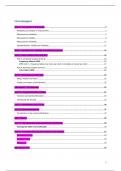Class notes
Research Methodology and Descriptive Statistics - Test 1 - Notes 2/2 - GRADE: 8.5
- Course
- Institution
- Book
This is 2/2 of my EXTENSIVE notes for Test 1 for the pre-master course Research Methodology and Descriptive Statistics on the University of Twente. With these notes, and the first part, you have a good knowledge to pass the first exam. I passed my exam with a 8.5! These notes consists of units 8 -...
[Show more]




